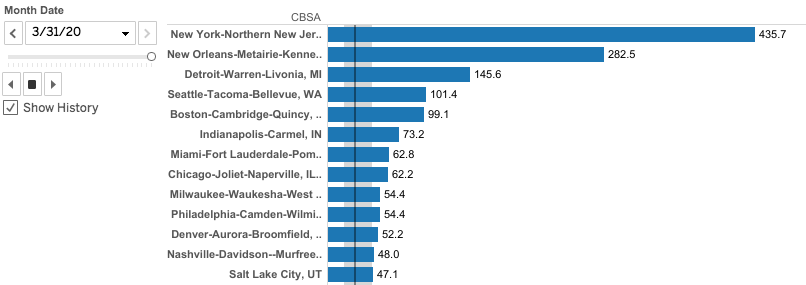What City Observatory this week
1. Counting Covid- Cases in US Metro Areas. We’ve been updating our metro area tabulations of the number of reported Covid-19 cases on a daily basis. You can find our latest tabulations here.
There’s a mixture of positive and negative developments. Seattle, the metro first hit hard by the pandemic, and among the first to institute social distancing, has seen its rate of new reported cases fall to the lowest level among the nation’s large metro areas–a still high 10 percent daily increase over the past week.
The more troubling developments are in New York which has, by far the nation’s highest incidence of reported cases (436 per 100,000 population on March 31, compared to the median large metro area, which as about 47 cases per 100,000), and in a number of cities where the rate of newly reported cases is growing faster than in the typical metro. New Orleans and Detroit have elevated levels of reported cases per capita. Cases are growing faster than the average large metro in Boston, Philadelphia, Miami and Indianapolis.
You can check back at our home page, www.CityObservatory.org–we’ll produce regular updates of our metropolitan tabulations of reported Covid-19 cases.
2. An animated view of the spread of the pandemic. We’ve used our daily metro level tabulations of reported cases per 100,000 population to produce an animated chart showing the growth of the pandemic from March 1 through March 31. You can view it here:
Must read
Privacy and the public interest in a pandemic. The New York Times has a provocative article discussing how we balance personal privacy rights of patients against the public interest in better understanding how to fight a deadly communicable disease. There’s wide variation among local health departments in releasing basic aggregated statistical data about the incidence and demographics of those who have contracted the Corona virus. Officials in Santa Clara County, California, for example refuse to release city specific data on the number of cases. Meanwhile, other countries (like Korea) are making pinpointed data on the location of new cases publicly available. What’s the right balance? As we move from a period of mandatory, and nearly universal quarantine, to a regime of testing and tracking, we’re going to have to reconsider our assumptions about whether privacy should trump releasing data that could help save lives. For what its worth, we routinely release pinpoint data on fatalities and injuries from traffic crashes (with personal information removed) to help understand, and try to minimize traffic deaths. Should we do any less with a pandemic?
In the News
Urban Milwaukee reported on our analysis of Covid-19 cases by metropolitan area, as did the Milwaukee Sentinel Journal.
Willamette Week reported that the private developers of Portland’s convention center headquarters hotel made a $40 million profit, essentially cashing in on $74 million in public subsidies for the project. City Observatory’s Joe Cortright is quoted as saying the deal was structured to give all of the upside to the private sector, and provided only downside risk for the public sector.



